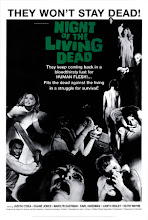
The Lady Of The Black Moons
aka Sayedat Al Akmar Al Sawdaa, La Dame Aux Lunes Noires
Director/Writer Samir A. Khouri
Cast Nahed Yousri (Aida), Hussein Fahmy (Omar), Adel Adham (Sami Bey)
 Poster for Nahed Yousri's Queen Of Love (1971)
Poster for Nahed Yousri's Queen Of Love (1971)
 Six months ago we screened our first ever Egyptian cult movie on Schlock Treatment called The Kuwait Connection from 1973. Those who saw it will have to admit it was baffling attempt to stitch together the horror, sexploitation, art film and political thriller into one strange mutant monster. It was one of two films which book-ended Egypt's brief flirtation with erotic cinema, a two year period of relaxed censorship restrictions between 1971 and 1973 during which Egyptian filmmakers made the country's most scandalous and salacious movies. The Lady Of The Black Moons was the first, filmed in Lebanon and directed by The Kuwait Connection's Samir A. Khouri, and featuring gorgeous and talented (not to mention adventurous) actress and superstar of Egyptian cinema, Nahed Yousri, as its lead.
Six months ago we screened our first ever Egyptian cult movie on Schlock Treatment called The Kuwait Connection from 1973. Those who saw it will have to admit it was baffling attempt to stitch together the horror, sexploitation, art film and political thriller into one strange mutant monster. It was one of two films which book-ended Egypt's brief flirtation with erotic cinema, a two year period of relaxed censorship restrictions between 1971 and 1973 during which Egyptian filmmakers made the country's most scandalous and salacious movies. The Lady Of The Black Moons was the first, filmed in Lebanon and directed by The Kuwait Connection's Samir A. Khouri, and featuring gorgeous and talented (not to mention adventurous) actress and superstar of Egyptian cinema, Nahed Yousri, as its lead.
 It's one of those films that throws you in the deep end of a pool after midnight, turns off the lights and watches your death throes while sipping a warm martini. The opening fractured montage eventually pieces together a disconcerting tableaux of a bored, well-to-do housewife in feathered mask bedding strangers in a house of ill-repute during a full moon; the woman, the film reveals in excruciatingly slow flashback, is Aida, married to successful, cold and cruel businessman Sami Bey, but tortured by memories of her lost love, their chauffeur Omar. Unable to embrace a man after her stepfather raped her at age ten, it takes a drunken Omar to open her rosebud; regardless, she chooses wealth and position over desire, and despite her valiant efforts to keep the affair alive, Omar ultimately rejects her, sending her into a downward spiral of depression and self-destruction. Her illicit attempts to recreate her beloved Omar out of strangers always end in castration – symbolically, the film suggests, despite the metaphor being hammered home several times with disturbing realism.
It's one of those films that throws you in the deep end of a pool after midnight, turns off the lights and watches your death throes while sipping a warm martini. The opening fractured montage eventually pieces together a disconcerting tableaux of a bored, well-to-do housewife in feathered mask bedding strangers in a house of ill-repute during a full moon; the woman, the film reveals in excruciatingly slow flashback, is Aida, married to successful, cold and cruel businessman Sami Bey, but tortured by memories of her lost love, their chauffeur Omar. Unable to embrace a man after her stepfather raped her at age ten, it takes a drunken Omar to open her rosebud; regardless, she chooses wealth and position over desire, and despite her valiant efforts to keep the affair alive, Omar ultimately rejects her, sending her into a downward spiral of depression and self-destruction. Her illicit attempts to recreate her beloved Omar out of strangers always end in castration – symbolically, the film suggests, despite the metaphor being hammered home several times with disturbing realism.
 The Lady Of The Black Moons is mostly early Seventies melodrama peppered with tease, violence, sexy smoking, ape-hair chests and the kind of flaming arch-pretentiousness that filmmakers managed to hold in reserve until the start of the Seventies. Symbolism abounds in its ragged, overt imagery and faux-poetry-as-dialogue, and even if at times our director isn't being deliberately oblique, it's tempting to look for meaning, however cracked, where no meaning can possibly exist. In key scenes the stench of pretension is impossible to miss: Sami's father, a wily trickster with a grotesquely over-developed sense of irony, gives Sami and Aida a distorted mirror as a wedding present. “Ugliness,” he reasons, “is but the mirror of the soul” - this nugget of wisdom coming from the chap who plays happy tunes under blown-up polaroids of the Hiroshima and Nagisaki blasts. Then there's the portrait mounted above Aida's bed of a white horse flanked by two brown horses; Aida later rides a white horse down the beach in her underwear, is met by Omar, and are filmed making sweet filthy love through the shimmering heat of three fish (that's THREE fish, remember) poaching over a fire. The horse, I'm certain, represents Aida's freshly unbridled sexuality, but what about the fish? Are THEY symbolic, and could they possibly be cyphers in an Islamic reinvention of the crucifixion triptych? Is it ALL, for that matter, just a load of symbolics? Has Meaning finally skewered itself in a bizarre piscine version of hari-kiri and now stares us down through parboiled eyes?
The Lady Of The Black Moons is mostly early Seventies melodrama peppered with tease, violence, sexy smoking, ape-hair chests and the kind of flaming arch-pretentiousness that filmmakers managed to hold in reserve until the start of the Seventies. Symbolism abounds in its ragged, overt imagery and faux-poetry-as-dialogue, and even if at times our director isn't being deliberately oblique, it's tempting to look for meaning, however cracked, where no meaning can possibly exist. In key scenes the stench of pretension is impossible to miss: Sami's father, a wily trickster with a grotesquely over-developed sense of irony, gives Sami and Aida a distorted mirror as a wedding present. “Ugliness,” he reasons, “is but the mirror of the soul” - this nugget of wisdom coming from the chap who plays happy tunes under blown-up polaroids of the Hiroshima and Nagisaki blasts. Then there's the portrait mounted above Aida's bed of a white horse flanked by two brown horses; Aida later rides a white horse down the beach in her underwear, is met by Omar, and are filmed making sweet filthy love through the shimmering heat of three fish (that's THREE fish, remember) poaching over a fire. The horse, I'm certain, represents Aida's freshly unbridled sexuality, but what about the fish? Are THEY symbolic, and could they possibly be cyphers in an Islamic reinvention of the crucifixion triptych? Is it ALL, for that matter, just a load of symbolics? Has Meaning finally skewered itself in a bizarre piscine version of hari-kiri and now stares us down through parboiled eyes?
 I, for one, get high on misguided art cinema, particularly if the “art” is nothing more than tarted-up sleaze. One one level it's the work of a filmmaker in a repressive regime given permission by authorities to test the limits of control – and he certainly does, although his The Kuwait Connection from 1973 helped slam the window of opportunity shut again. On another level, it's a morality play from the Muslim world in which wickedness is ultimately punished (“I'm a slut dirty!” Aida's subtitle proclaims) but not after the privileged audience cops one steaming eyeful of said wickedness after the other. On final scrutiny, The Lady Of The Black Moons is like many of its European contemporaries, a simple soap opera gussied up with tits and art; to his credit, Khouri indulges in the same highbrow pulp as prolific Spanish cinemaniac Jess Franco, with only a whiff of Franco's customary surrealism and deranged psychedelic visuals that go full-tilt in Khouri's next film The Kuwait Connection. It's imaginatively photographed, sadly nowhere near as sleazy, violent or weird as its follow-up, and at times threatens to collapse under the weight of such turgid lines as Omar's when driving past a cemetery: “Can they keep loving each other after death?” Not only that, you have to admit that Nahed Yousri makes a fantastic slut dirty. Time to cover the windows with cardboard and take out the lightbulbs with hammers as we visit The Lady Of The Black Moons.
I, for one, get high on misguided art cinema, particularly if the “art” is nothing more than tarted-up sleaze. One one level it's the work of a filmmaker in a repressive regime given permission by authorities to test the limits of control – and he certainly does, although his The Kuwait Connection from 1973 helped slam the window of opportunity shut again. On another level, it's a morality play from the Muslim world in which wickedness is ultimately punished (“I'm a slut dirty!” Aida's subtitle proclaims) but not after the privileged audience cops one steaming eyeful of said wickedness after the other. On final scrutiny, The Lady Of The Black Moons is like many of its European contemporaries, a simple soap opera gussied up with tits and art; to his credit, Khouri indulges in the same highbrow pulp as prolific Spanish cinemaniac Jess Franco, with only a whiff of Franco's customary surrealism and deranged psychedelic visuals that go full-tilt in Khouri's next film The Kuwait Connection. It's imaginatively photographed, sadly nowhere near as sleazy, violent or weird as its follow-up, and at times threatens to collapse under the weight of such turgid lines as Omar's when driving past a cemetery: “Can they keep loving each other after death?” Not only that, you have to admit that Nahed Yousri makes a fantastic slut dirty. Time to cover the windows with cardboard and take out the lightbulbs with hammers as we visit The Lady Of The Black Moons.
























































































No comments:
Post a Comment